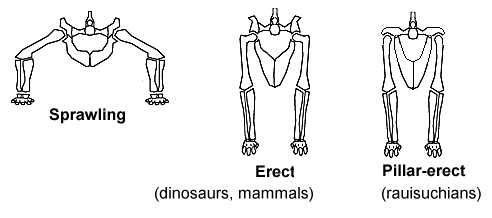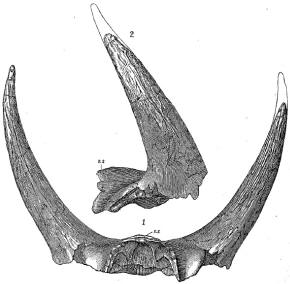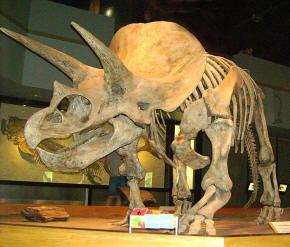|
Triceratops has been
documented by numerous remains collected since the genus was first described
in 1889, including at least one complete individual skeleton. Paleontologist
John Scannella observed: "It is hard to walk out into the
Hell Creek Formation
and not stumble upon a triceratops weathering out of a hillside."
Forty-seven complete or partial skulls were discovered in just that area
during the decade 2000–2010. Specimens representing life stages from
hatchling to adult have been found.
The function of the frills and three distinctive
facial horns has long inspired debate. Traditionally these have been viewed
as defensive weapons against predators. More recent theories, noting the
presence of blood vessels in the skull bones of ceratopsids, find it more
probable that these features were primarily used in identification, courtship and dominance
displays, much like the antlers and horns of
modern reindeer, mountain goats, or
rhinoceros beetles. The
theory finds additional support if
Torosaurus
represents the mature form of Triceratops,
as this would mean the frill also developed holes (fenestrae) as individuals
reached maturity, rendering the structure more useful for display than
defense.
Description
Individual
Triceratops are estimated
to have reached about 7.9 to 9.0 meters (26.0–29.5 feet) in length, 2.9 to
3.0 meters (9.5–9.8 feet) in height, and 6.1–12.0 tonnes (13,000–26,000
lb) in weight. The most
distinctive feature is their large skull, among the
largest of all land animals. The largest known skull (specimen BYU 12183) is estimated
to have been 2.5 metres (8.2 ft) in length when complete, and could reach
almost a third of the length of the entire animal. It bore a single horn on
the snout, above the nostrils, and a pair of
horns approximately 1 m (3 ft) long, with one above each eye. To the rear of
the skull was a relatively short, bony frill. Most other ceratopsids had
large fenestrae in their
frills, while those of
Triceratops
were noticeably solid.
The skin of
Triceratops was unusual
compared to other dinosaurs. Skin impressions from an as-yet undescribed
specimen show that some species may have been covered in bristle-like
structures, similar to the more primitive ceratopsian
Psittacosaurus.
Limbs
Triceratops
species possessed a sturdy build, with strong limbs and short three-hoofed
hands and four-hoofed feet. Although certainly quadrupedal, the
posture of these dinosaurs has long been the subject of some debate.
Originally, it was believed that the front legs of the animal had to be sprawling at angles
from the thorax, in order to
better bear the weight of the head.
However,
ichnological evidence
in the form of
trackways from horned
dinosaurs, and recent reconstructions of skeletons (both physical and
digital) seem to show that Triceratops
and other ceratopsids maintained an upright stance during normal locomotion,
with the elbows flexed and slightly bowed out, in an intermediate state
between fully upright and fully sprawling (as in the modern rhinoceros). the animal had to be sprawling at angles
from the thorax, in order to
better bear the weight of the head.
However,
ichnological evidence
in the form of
trackways from horned
dinosaurs, and recent reconstructions of skeletons (both physical and
digital) seem to show that Triceratops
and other ceratopsids maintained an upright stance during normal locomotion,
with the elbows flexed and slightly bowed out, in an intermediate state
between fully upright and fully sprawling (as in the modern rhinoceros).
The hands and forearms of
Triceratops retained a
fairly primitive structure compared to other quadrupedal dinosaurs such as
thyreophorans and many
sauropods. In those two
groups, the forelimbs of quadrupedal species were usually rotated so that
the hands faced forward with palms backward ("pronated") as the animals
walked. However,
Triceratops,
like other ceratopsians and the related quadrupedal ornithopods, walked
with most of their fingers pointing out and away from the body, the
primitive condition for dinosaurs also retained by bipedal forms like the
theropods. In
Triceratops, the weight of
the body was carried by only the first three fingers of the hand, while the
third and fourth were vestigial and lacked claws or hooves.
Discovery
and identification
The first named specimen now
attributed to Triceratops
is a pair of brow horns attached to a skull roof, found near Denver, Colorado in the
spring of 1887. This specimen was sent to
Othniel Charles Marsh,
who believed that the formation from which it
came dated from the
 |
| Illustration of specimen YPM 1871E, the horn cores that were
erroneously attributed to Bison alticornis, the first named
specimen of Triceratops |
Pliocene, and that the
bones belonged to a particularly large and unusual bison, which he named
Bison alticornis.
He realized that there were horned dinosaurs by the next year, which saw his
publication of the genus
Ceratops from
fragmentary remains, but he still believed B.
alticornis to be a Pliocene mammal. It took a third
and much more complete skull to change his mind. The specimen, collected in
1888 by
John Bell Hatcher from
the
Lance Formation of
Wyoming, was initially
described as another species of
Ceratops.
After reflection, however, Marsh changed his mind and gave it the generic
name Triceratops,
accepting his Bison alticornis
as another species of Ceratops
(it would later be added to Triceratops).
The sturdy nature of the animal's skull has ensured that many examples have
been preserved as fossils, allowing
variations between species and individuals
to be studied.
Triceratops
remains have subsequently been found in the American states of Montana and South Dakota (in
addition to Colorado and Wyoming), and in the Canadian provinces of
Saskatchewan and Alberta.
Return to the
Old Earth Ministries Online Dinosaur
Curriculum homepage.

Shopping
Bay
State Replicas - Skull, humerous (juvenile), nasal horn core, vertebra,
brow hown,
Black
Hills Institute - Skeleton, skull, femer, dentary, predentary,
supraorbital horn, nasal horn
|


 the animal had to be sprawling at angles
from the thorax, in order to
better bear the weight of the head.
However,
the animal had to be sprawling at angles
from the thorax, in order to
better bear the weight of the head.
However, 